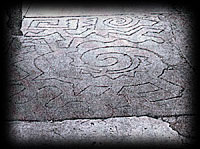
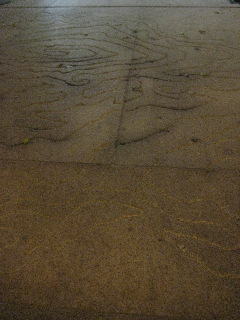
I’d met Ken Rock, sitting on the sidewalk.
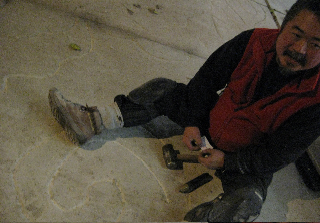
That’s what he does, part of the time. Sit on the side walk and hammer away. Looking from further down the block, I’d wondered what that person was doing. It was nightfall. And it was cold. Bond Street. His real name, however, isn’t Ken Rock. It’s Kenichi Hiratsuka. And his site speaks:
Hiratsuka’s stone works are characterized by maze-like designs of infinite variation, always formed by one continuous line that never crosses itself. Hiratsuka often refers to his works as “fossils of the moment.” They are both modern and ancient, a symbol of human communication through universal language on the surface of the earth as one huge rock.
For a lover of the labyrinthine pattern, I found his line compelling. And I’ve been talking about lines. And what lines are drawn. And what lines each of us makes. A pattern of our experience. Our experience, patterned. But moreover, his visioning is about drawing people together. And if, for only a moment, people look down and wander in, the patterning of the maze, a line drawn in the concrete. And maybe there’s a chance that someone will contemplate that reflection. That they reflect. What is reflection? To mirror what’s seen, scene. And in a manner, the noble intentions of Ken are about drawing people into his maze, into each — for just that moment as you see, they see, we all see, the patterning shared.
I’ve spent a lot of time studying the maze (amazing) — and the journey of the maze is about the same winding of living. You find your way, you are lost, you are confused, you find your way. You are living (amazement).
Like living, you see the thread and you can either pay attention and look for it, or you can wander the chiseled line and meander. Then some thing will be found in either gathering, in either stride.
Like living, simple tools will get you there. Stone, chisel, hammer.
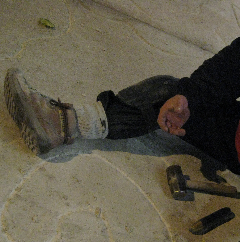
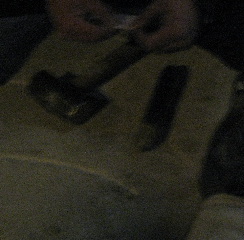
Meanwhile, Ken sits there, cutting the wandering line. And we can look to see what trail might be uncovered, what new mystery unearthed.
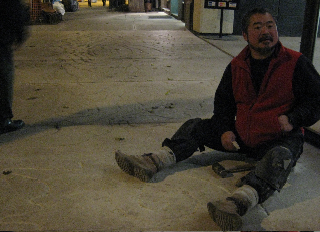
Find that grain, that whorl, that brings you in. Ken leads the way. Look in.
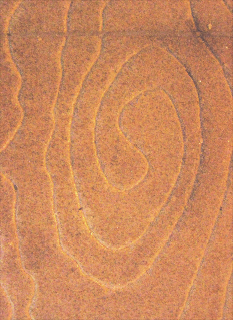
maze (
n.)
……..
1297, “delusion, bewilderment,” possibly from O.E. *mæs, which is suggested by the compound amasod “amazed” (see amaze). Perhaps related to Norw. dial. mas “exhausting labor.” Meaning “labyrinth” first recorded c.1385.
labyrinth (n.)
…….
1387, from L. labyrinthus, from Gk. labyrinthos “maze, large building with intricate passages,” esp. the structure built to hold the Minotaur, from a pre-Gk. language; perhaps related to Lydian labrys “double-edged axe,” symbol of royal power, which fits with the theory that the labyrinth was originally the royal Minoan palace on Crete and meant “palace of the double-axe.” Used in Eng. for “maze” early 15c., and in figurative sense of “confusing state of affairs” (1548).
amaze (v.)
……..
c.1230, amasian “stupefy, make crazy,” from a-, probably used here as an intensitive prefix, + -masian, related to maze (q.v.). Sense of “overwhelm with wonder” is from 1592. Amazing in the sense of “great beyond expectation” is first recorded 1704.
“I hope that those who see my work will discover new aspects of life, deeper levels of experience of which they may be only dimly aware. I want to inspire people to become more conscious of nature and our common humanity. No matter how lifestyles change, the basic self remains the same. I want to help bring human beings together. In my art there are no social, economic, cultural or political distinctions. We are all one.” KH
TSG | NYC